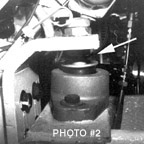Troubleshooting Problems Involving
Engine/Shaft Alignment
by David H. Pascoe, Marine Surveyor
| Page 1 | Page 2 | Page 3 |
When it comes to yacht maintenance, one of the
least understood and most overlooked systems that require maintenance,
engine and shaft alignment probably heads the list. Here's a short list of
the problems associated with incorrect alignment and poor or worn out
engine mounts:
- Rapid bearing wear.
- Causes stuffing boxes to wear out and leak, not infrequently sinking the boat.
- Bent or broken shafts
- Drive system vibration that can damage transmissions, engine mounts and the boat hull itself.
- Transmission failure caused by increased stress on the rear output shaft bearings and gears.
- Loosening of struts, causing leaking and possible sinking.
- Oscillating propeller shaft causing stuffing box clamps to loosen and work free, usually sinking the boat.
- Wear or worn out engine mounts cause drive shaft misalignment to stern drive, causing universal joints to oscillate and wear out.
These are but a few of the damages that can be caused by
basic engine/shaft misalignment. Now comes a discussion of why, unlike in
an automotive applications, boat engine drive systems do not indefinitely
remain in alignment and need to be periodically checked and realigned.
People tend to think of boats and yachts as being rigid structures, but
they're not. The fact is that boats bend and twist in all directions,
albeit not to any degree that's visually detectable. Expecially fiberglass
boats, because they are a thermosetting plastic, can change their shape
over time. This can happen either as a result of improper hauling and
shoring, or it can happen simply as a factor of age and the effects of
gravity.

Photo #2
This type of mount is fine for gas engines but not for heavy diesels. This mount, on a brand new 45 footer, is badly distorted. Note how it is cocked toward the engine and forward. In this case, the mounts allowed the engine to move so much that the shaft coupling came apart.
However, the primary reason why drive systems do not stay in line
indefinitely is due to wear and tear on all the components that make up
the system. Stress, vibration, friction, slamming and pounding are all
factors that contribute the changing size and shape of all physical
objects. Foremost among these are the engine mounts. Remember that it is
the engine mounts that carry nearly all of the thrust load of the
propeller and transfers it to the hull. Obviously, then, the engine mounts
should be well-designed and strong. Unfortunately, more often than not the
builder has selected the most inexpensive mounts that he can buy, mounts
that are not going to do a very good job of keeping the system in
alignment.
In fact, the most commonly used engine mounts for gas and small diesels is
a mount that does a very poor job of maintaining alignment. Shown in the
photo above, this mount not only permits the engine to rock forward and
back, but up and down and laterally also. It literally allows the engine
to move like a hobby horse.
A basic rule in engine alignment system is that that larger the vessel,
the longer and larger diameter the shaft, the more critical alignment is.
That's because any misalignment becomes magnified over the length of the
shaft; the longer the shaft, the greater the potential error. A shaft
that's centered at the strut bearing can easily be off by several inches
with only a change in a degree or two of angle at the engine. This factor
is what accounts for why shaft misalignment can cause so much damage on
any shafting system of considerable length.
This is also why small boats can get away with a great deal of
misalignment, and why they can get away with using cheap, inferior mounts.
A shaft that is only ten feet long can tolerate ten times the amount of
misalignment of a shaft that is twenty feet long. But by the time you get
up to a forty-footer with a 15' shaft, the amount of movement and
misalignment in the system that it can tolerate without causing damage
declines dramatically.
At this point, the thickness and mass of both
the shaft, propeller and the drive load all begins to play
an increasingly important role. The reason is simply because
small diameter shafts are much more elastic than large diameter
shafts. All boat shafting systems are self-centering to
some degree, but the larger the diameter shaft, the less
self-centering it becomes. The shaft does not bend but transfers
all that misdirected energy (vibration) to other components
such as struts, bearings, transmission and the engine mounts. Continued
to Page Two
| Page 1 | Page 2 | Page 3 |
Contents
-
Page One
- List of Problems
- Reason why drive systems do not stay in line
-
Page Two
- How to check your system
-
Page Three
- Dial Indicating Shafts
- Weak Strut
First posted on April 19, 1997 at David Pascoe's
site www.yachtsurvey.com.
Page design changed for this site.
Power Boat Books
 Mid Size Power Boats
Mid Size Power Boats A Guide for Discriminating Buyers
Focuses exclusively cruiser class generally 30-55 feet
With discussions on the pros and cons of each type: Expresses, trawlers, motor yachts, multi purpose types, sportfishermen and sedan cruisers.
Selecting and Evaluating New and Used Boats
Dedicated for offshore outboard boats
A hard and realistic look at the marine market place and delves into issues of boat quality and durability that most other marine writers are unwilling to touch.
2nd Edition
The Art of Pre-Purchase Survey The very first of its kind, this book provides the essentials that every novice needs to know, as well as a wealth of esoteric details.
Pleasure crafts investigations to court testimony The first and only book of its kind on the subject of investigating pleasure craft casualties and other issues.






